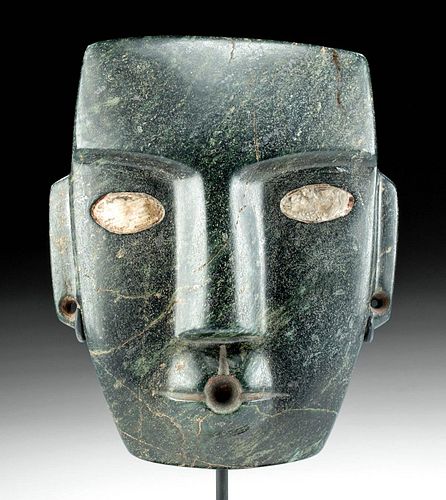Guerrero Chontal Greenstone Mask Shell Inlay Eyes
Lot 181
About Seller
Artemis Fine Arts
686 S Taylor Ave, Ste 106
Louisville, CO 80027
United States
Selling antiquities, ancient and ethnographic art online since 1993, Artemis Gallery specializes in Classical Antiquities (Egyptian, Greek, Roman, Near Eastern), Asian, Pre-Columbian, African / Tribal / Oceanographic art. Our extensive inventory includes pottery, stone, metal, wood, glass and textil...Read more
Estimate:
$15,000 - $22,500
Absentee vs Live bid
Two ways to bid:
- Leave a max absentee bid and the platform will bid on your behalf up to your maximum bid during the live auction.
- Bid live during the auction and your bids will be submitted real-time to the auctioneer.
Bid Increments
| Price | Bid Increment |
|---|---|
| $0 | $25 |
| $300 | $50 |
| $1,000 | $100 |
| $2,000 | $250 |
| $5,000 | $500 |
| $10,000 | $1,000 |
| $20,000 | $2,500 |
| $50,000 | $5,000 |
| $100,000 | $10,000 |
| $200,000 | $20,000 |
About Auction
By Artemis Fine Arts
Oct 7, 2021
Set Reminder
2021-10-07 10:00:00
2021-10-07 10:00:00
America/New_York
Bidsquare
Bidsquare : Exceptional Antiquities Ethnographic Fine Art
https://www.bidsquare.com/auctions/artemis-gallery/exceptional-antiquities-ethnographic-fine-art-7537
Museum-worthy examples of Egyptian, Greek, Roman, Etruscan, Near Eastern, Far East / Asian, Pre-Columbian, African / Tribal, Oceanic, Native American, Spanish Colonial, Fossils, Ancient Jewelry, Fine / Visual Arts, so much more! Artemis Fine Arts info@artemisgallery.com
Museum-worthy examples of Egyptian, Greek, Roman, Etruscan, Near Eastern, Far East / Asian, Pre-Columbian, African / Tribal, Oceanic, Native American, Spanish Colonial, Fossils, Ancient Jewelry, Fine / Visual Arts, so much more! Artemis Fine Arts info@artemisgallery.com
- Lot Description
Pre-Columbian, Central Mexico, Guerrero region, Chontal, Late Preclassic period, ca. 300 to 100 BCE. A gorgeous face mask of an oblong form, hand-carved from an attractive greenstone of deep grey-green hues with wonderful creamy white veining patterns. The minimalist visage features a pair of inset ovoid eyes holding grey shell inlays beneath angled brows, lengthy, bar-shaped ears pierced with annular drill holes for suspending ornaments, a rectangular nose, and a projecting mouth held open in an "O" shape. The mouth is adorned with a horizontal striation at either side and vertical striation at its top, likely to represent ceremonial scarification. Chontal stone sculpture deviates from the earlier Guerrero-region sculptural style by being more naturalistic rather than highly abstracted geometric human figures made by the Mezcala, and that development is seen here. The name "Chontal" probably comes from the Aztec, who called the people of this region "Chontales." Size: 5.1" W x 6.4" H (13 cm x 16.3 cm); 8.3" H (21.1 cm) on included custom stand.
The Guerrero region of modern-day southwestern Mexico was the center of the Mezcala and Chontal stone carving traditions. While Mezcala artists are known for their abstract, geometric style, the Chontal sculptors imbued their artworks with more naturalism. Although their stonework stems from the Preclassic period, ca. 300 to 100 BCE, later Mesoamerican peoples clearly cherished Chontal portable sculptures as heirlooms. Chontal creations have been associated with Templo Mayor, the principal temple of the 15th century Aztecs of Tenochtitlan (Mexico City).
What's more, legendary 20th century modernists such as Diego Rivera, Frida Kahlo, and Miguel Covarrubias appreciated the minimalist qualities of Chontal art. Covarrubias went so far as to compare it to the Cycladic style of ancient Greece. Scholars believe that such masks as this example were tied to funerary bundles of the noble elite; however, smaller scale masks suggest they may have been attached to clothing.
This piece has been searched against the Art Loss Register database and has been cleared. The Art Loss Register maintains the world's largest database of stolen art, collectibles, and antiques.
Provenance: private Los Angeles, California, USA collection, acquired in the 1960s
All items legal to buy/sell under U.S. Statute covering cultural patrimony Code 2600, CHAPTER 14, and are guaranteed to be as described or your money back.
A Certificate of Authenticity will accompany all winning bids.
PLEASE NOTE: Due to recent increases of shipments being seized by Australian & German customs (even for items with pre-UNESCO provenance), we will no longer ship most antiquities and ancient Chinese art to Australia & Germany. For categories of items that are acceptable to ship to Australia or Germany, please contact us directly or work with your local customs brokerage firm.
Display stands not described as included/custom in the item description are for photography purposes only and will not be included with the item upon shipping.
#167936A few stable hairline surface fissures across front and verso, as well as 1 larger fissure with minor loss to upper right corner. Otherwise, intact and excellent with impressive remaining detail.Condition
- Shipping Info
-
All shipping is handled in-house for your convenience. Your invoice from Artemis Gallery will include shipping calculation instructions. If in doubt, please inquire BEFORE bidding for estimated shipping costs for individual items.
-
- Buyer's Premium



 EUR
EUR CAD
CAD AUD
AUD GBP
GBP MXN
MXN HKD
HKD CNY
CNY MYR
MYR SEK
SEK SGD
SGD CHF
CHF THB
THB














